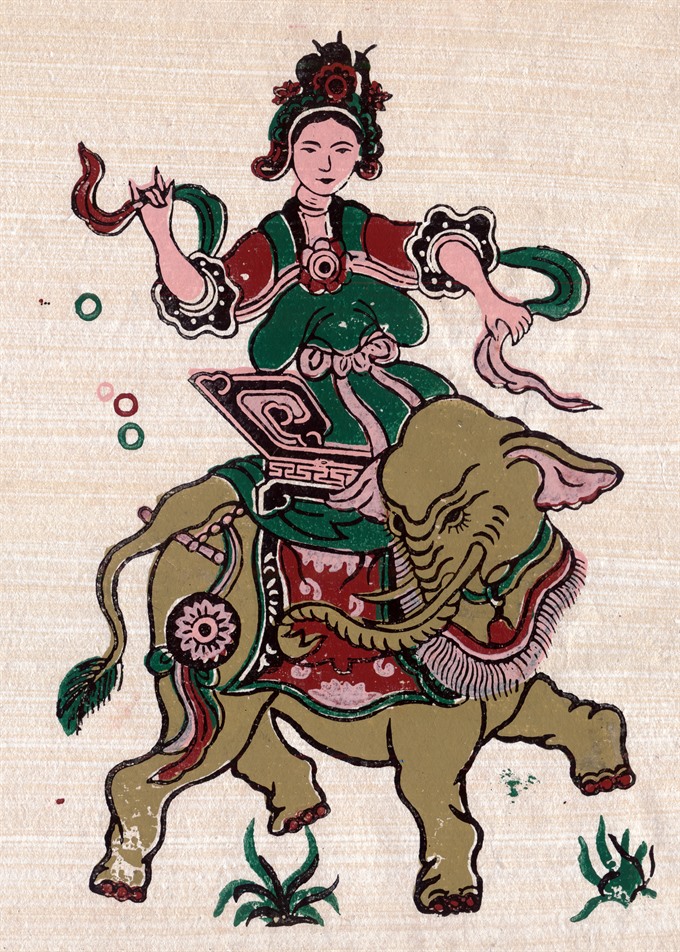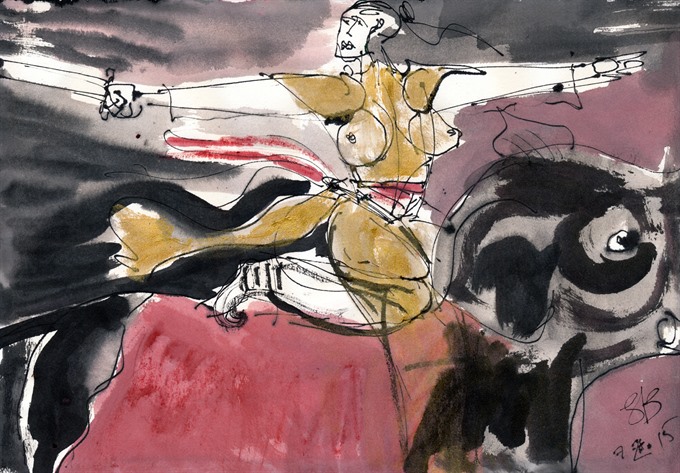 Features
Features

An unexpected 'discovery' of a legendary woman who was more than warrior and more than a feminist as she fought for freedom from all forms of oppression awes and inspires George Burchett
 |
| Modest heroine: Đông Hồ woodblock painting depicting Bà Triệu on her elephant. |
Some time ago, I visited the Hai Bà Trưng Temple in Mê Linh District, near Hà Nội, dedicated to the legendary Trưng sisters. Every Vietnamese citizen knows the story of the two sisters, Trưng Trắc and Trưng Nhi, who, almost two millennia ago, led their armies into battle against the northern domination.
Ladies riding elephants into battle worked on my artistic imagination. I wanted to learn more about the Trưng sisters and did what everyone does these days, googled them.
But instead of the Trưng Sisters, it was Bà Triệu or Lady Triệu who came to me from cyberspace.
Here’s a summary of her story, based on various scholarly sources.
Let me start with her physical attributes.
She was 9 feet tall, that is 2.74 metres.
Her breasts were 3 feet or 0.91 metres in size.
Another source says 3 thước or 1.2 metres.
Her voice was "like a temple bell, and she was able to eat several pecks of rice and walk five hundred leagues in a single day. She also possessed a beauty that could shake the soul of any man."
Distinguished contemporary scholar Hữu Ngọc makes this remark in the essay on Bà Triệu in his book Wandering through Vietnamese Culture:
"In the old Vietnamese society strongly marked by Confucianism, young daughters of orthodox families often had to bind their somewhat buxom chests in order not to be branded as "indecent" by people of "good breeding".
An 18th century woodblock print depicts her through a Confucian prism, waving ribbons, amble bosom modestly concealed.”
All of which suggests that the legendary Bà Triệu was somehow "indecent" and of not very "good breeding". In other words, she was not an aristocrat like the Trưng Sisters, but a commoner, a peasant. Which, for me, makes her all the more fascinating.
Bà Triệu was born Triệu Thị Trinh or Triệu Trinh Nương in a mountainous area of Thanh Hóa Province in 225 AD. She was orphaned at an early age and lived with her elder brother, Triệu Quốc Đạt and his wife. She was independent minded and well versed in the martial arts. She didn’t get on with her cantankerous sister-in-law. One day, Triệu Thị Trinh lost her temper and — probably inadvertently — killed her brother’s wife. She escaped to the nearby mountains and gathered a hardy band of braves to harass the Chinese occupiers. She was then 19. Her brother went to her hideout to talk her into returning home. She answered him with these famous words, familiar to all Vietnamese:
Tôi chỉ muốn cưỡi cơn gió mạnh, đạp luồng sóng dữ, chém cá trường kình ở biển Đông, lấy lại giang sơn, dựng nền độc lập, cởi ách nô lệ, chứ không chịu khom lưng làm tì thiếp cho người!
"I want to ride the wind and walk the waves, slay the sharks in the Eastern Sea. I want to drive out the enemy and free our people. Why should I imitate others, bow my head, stoop over and be a slave? I will not resign myself to our usual women’s lot, bowing our heads to become concubines."
Her brother was so impressed by her feisty spirit that he joined her rebellion.
 |
| Stuff of legends: Bà Triệu, sketch by George Burchett |
Triệu Thị Trinh appeared at a time when Việt Nam had been subjugated by the Chinese for nearly five centuries; at a period when Chinese rule, under the Wu dynasty (AD222-280), was particularly harsh. The population was heavily taxed and exploited. Thousands of skilled Vietnamese artisans were exiled to help build the new capital of the Wu. Popular discontent led to revolts and uprisings that were brutally repressed.
In his book To Arm The Revolutionary Masses, to Build the People’s Army (Hà Nội, 1974), General Võ Nguyên Giáp mentions Bà Triệu’s insurrection against the occupier as the fourth of ten important revolts before the Chinese were finally expelled in 938 AD.
Legend says that Bà Triệu rode into battle on a war elephant, wearing a golden tunic, her ample breasts flung over her shoulders. Her small guerilla army scored victory after victory against the Chinese occupiers and more and more people joined her rebellion. Finally, the Chinese sent one of their top generals, Lu Yin to put an end to the armed insurrection.
The Imperial troops were petrified by Bà Triệu’s extraordinary beauty and her hypnotic gaze. But she had one weakness: she could not tolerate anything dirty and impure. So during a battle, the cunning general ordered his man to drop their pants and kick up a lot of dust. Disgusted by the spectacle, Bà Triệu turned her elephant around and left the battlefield. Her men followed her in confusion and were decimated. Rather than surrender, Bà Triệu committed suicide.
But that wasn’t quite the end of Bà Triệu. She kept tormenting General Lu Yin in his dreams and a pestilence spread among his troops soon after Bà Triệu’s demise. To drive away her spirit, the general ordered craftsmen to carve hundreds of wooden penises and hang them on doors.
Throughout the centuries, Bà Triệu kept appearing in the dreams of Vietnamese heroes fighting invaders, to inspire them and offer spiritual support. She was honoured by the official court with various posthumous titles. Historian David Marr comments:
"As Lê dynasty (1428 — 1788) scholars moved to bring Vietnamese practices into conformity with Neo-Confucian doctrine, they must have agonized often about what to do with Triệu Thị Trinh. It is not insignificant that she survived all their manipulations. Today, she is revered as one of Vietnam’s great women heroes."
And this is how she appeared to me, from cyber space, and how I captured her in many sketches…
Always in the same pose, in her shining golden tunic, riding a mighty war elephant , arms stretched in opposite directions, each hand holding a sword, hair tied with a red ribbon like a wild horse’s tail, a red sash around her waist, flying behind her like two wings, bosom thrust forward, like the prow of a boat.
So what is it that struck me about Bà Triệu?
Her amazing physique?
Well, yes, throughout the centuries, artists have been inspired by gods and goddesses, mythical beings and super- heroes, legends and stories about them. They are recycled in popular culture as Hercules, Xena, Thor, Wonder Woman and so on. So why not a mighty woman warrior from a distant past riding an elephant? It is certainly a striking vision.
Her words?
"I want to ride the wind and walk the waves, slay the sharks in the Eastern sea. I want to drive out the enemy and free our people."
To me these words conjure up two iconic images from Western art: Eugene Delacroix’s La Liberté Guidant le Peuple (Liberty Guiding the People) painted in 1830 and the classic marble Victory of Samothrace, created by a Greek sculptor in the second century BC.
And they in turn evoke Hồ Chí Minh’s words:
"Nothing is more precious than Independence and Liberty."
She also says:
"I want to drive out the enemy and free our people. Why should I imitate others, bow my head, stoop over and be a slave? I will not resign myself to our usual women’s lot, bowing our heads to become concubines."
Bà Triệu rebels against two layers of oppression:
The domestic petty tyrants, who want to submit her with rules she cannot accept.
And the external enemy, who enslaves her people, plunders the land and imposes a culture with a rigid moralistic philosophy that confines women to domestic slavery.
For a simple peasant girl, she makes a surprisingly sophisticated analyses of the plight of her people and that of her own gender, binding these together as the enemy she must fight. She will be neither slave to a foreign power, nor be a woman who bows her head and becomes a mere concubine condemned to domestic work.
And she comes to her own conclusion: armed struggle.
To be truly free and independent, she must fight both the external coloniser and the oppressive social system that forces her into a submissive role.
In other words, she must fight both feudalism and colonialism, which was also the goal of Hồ Chí Minh’s revolution.
So Bà Triệu is not just one of Việt Nam’s great women heroes, she is one of Việt Nam’s great revolutionary leaders.
Not bad for a 19-year old peasant girl!
Feminists will want to claim her as one of their own – and they are right.
But there is more to Bà Triệu than just feminism.
She rebelled against an oppressive social order that also enslaved her people.
She is pure, she cannot stand anything dirty and corrupt.
She is an idealist.
I believe that as her stature and prestige among the people grew, so did her physical size grow in popular imagination.
Until she became a beautiful giant, to be both admired and feared!
Admired by those fighting for freedom and justice.
Feared by the oppressors, the corrupt, the impure.
Bà Triệu, like modern super-heroes, still has and will have many battles to fight.
But unlike most super-heroes of pop culture, Bà Triệu has her roots in her people, she is one of them. The people made her bigger than life as a tribute to her spirit and courage. They gave her an ample bosom in defiance of oppressive Confucian morals. Bà Triệu was strong and free in a society that required women to be weak and submissive. And a society where women are weak and submissive is itself weak and oppressive.
Vietnamese women have played a prominent role throughout Việt Nam’s history, not only on battlefields, but in all other areas: culture, education, science, economy. Bà Triệu is an early embodiment of that spirit, very feminine, but also strong and resolute.
I salute Bà Triệu, forever young, strong, beautiful and pure!
May she inspire many more generations to fight for justice and equality, for a world free of oppression, corruption and tyrants, small, medium and large, domestic and external. — VNS




